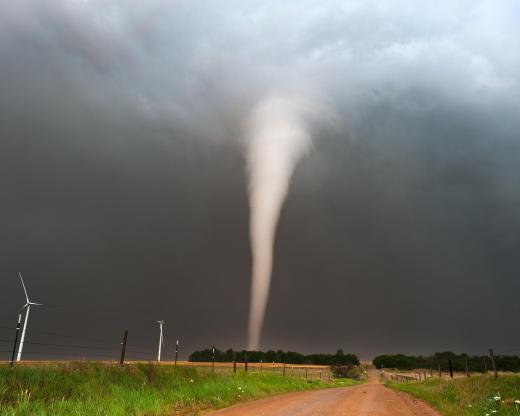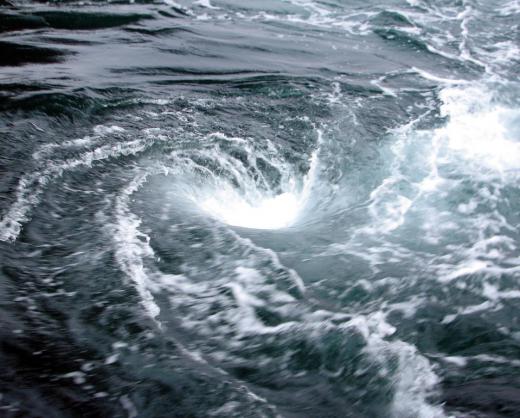What is a Vortex?
A vortex can refer to a number of different things, all of which deal with motion. In physics, it is the name given to matter that is whirling around a specific center. In nature, a vortex is a type of phenomenon such as a tornado. In a laboratory, it is a specific piece of machinery used for mixing. In fiction, the term usually refers to a type of dimensional gateway.
A vortex in physics is an occurrence where matter whirls in a spiral pattern. The matter usually has to have a specific level of cohesion and flexibility for this to occur, such as that associated with liquids and gases. The pressure at the core of the spiral is the least, the outer edges the most. A line called the vortex line can be drawn down the center of this area.

Vortexes, or vortices, often occur in nature. Dust devils, water spouts, tornadoes, and hurricanes are all examples. They are caused by air flow and clouds, and are visible due to either the water vapor or solid matter that is sucked into them. Vortices that occur in water are called whirlpools. Whirlpools are rare in nature, but usually occur due to either rough water or the creation of lower pressure areas in the water. The term vortex can also be associated with various magnetic and astronomical occurrences.

A vortex is also a helpful piece of laboratory equipment. In a lab, it is usually a simple, hand-sized device that is set on top of a table; a test tube containing liquid is gently pressed against the top of the device. The device rotates the test tube in a way that creates a vortex inside of it. This stirs the contents of the test tube extremely well, and is why the device can be found in most chemistry labs.

Vortices have also found their way into fiction. In science fiction, they are often described as galactic anomalies such as wormholes that allow travel either over large distances or through time. In fantasy, they usually act as portals to other dimensions. In ancient myths and legends, vortices tend to be massive whirlpools that destroy ships.
AS FEATURED ON:
AS FEATURED ON:













Discussion Comments
I seem to remember hearing that a vacuum cleaner operates with a vortex. The air spins while it sucks up the dirt and throws it into a filter, right?
The only whirlpools I've ever seen were in a river near a dam. The giant turbines beneath the water created huge, scary swirls that I'm sure could have sucked a boat or a person in if they got too close.
Even though I was looking at them from behind a guard rail, I still felt unsafe. The only way I could have been in danger was if someone picked me up and threw me over, but still, I envisioned myself spinning underwater.
While these were scary, they weren't as scary as the waterspout I saw while on vacation at the Gulf Coast. I was on the balcony of the hotel, and I could see two waterspouts forming over the ocean on the horizon. They were vortices made of water, so they could spin you and drown you at the same time!
@Oekc05: Thank you very much. I thought that was the case but needed another opinion. Thanks again.
@don1carter: I believe that tornadoes do actually fling debris. Consider all the trees and boards that travel at high enough speeds to pierce houses and other trees. I've seen this a lot, because I live in tornado alley.
Though I've never been in an actual tornado, I've seen plenty of the damage they can cause. So, I do believe that they can throw objects at high velocity into other objects.
I remember creating vortexes in glass bottles as a child. There was a kind of lemonade that came with little yellow edible balls in it, and you could shake it up and watch them swirl.
It was pretty cool how they would form a very thin twister right inside the liquid. It probably would have been impossible to see without the yellow balls inside it.
In a work of fiction, would it be wrong or silly to refer to something being "flung off of a vortex," since in reality they suck things toward their center? I'm thinking, for example, of debris scattered by a tornado. Is such debris ever flung out of the storm?
Post your comments